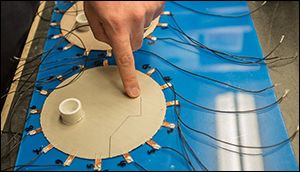‘Sensing Skin’ Detects Cracks, Harmful Chemicals in Structures
11. 10. 2016 | NC State University | news.ncsu.edu
Researchers have developed a multi-layered “sensing skin” to detect corrosive or otherwise harmful substances in structures. The skin can also detect cracks and other structural flaws that are invisible to the naked eye.
The sensing skin consists of three layers, which can be painted onto the surface of a structure or pre-assembled and attached to the surface like wallpaper. The first layer is electrically conductive and is used solely to detect cracks. The second layer serves as a buffer between the first and third layers. The third layer detects cracks, but is also engineered to detect specific chemicals of interest.

This third layer incorporates metal nanoparticles whose conductivity changes in the presence of specific ions. By changing the composition of the metal nanoparticles, this layer can be engineered to respond to any particular chemical.
If users want to monitor for chemicals coming out of a structure – such as leakage of the chemicals out of a containment structure – the third layer would face inward, touching the structure’s surface. To monitor external chemicals, the third layer would face outward.
Read more at NC State University
Image Credit: Julie Williams Dixon
-jk-




